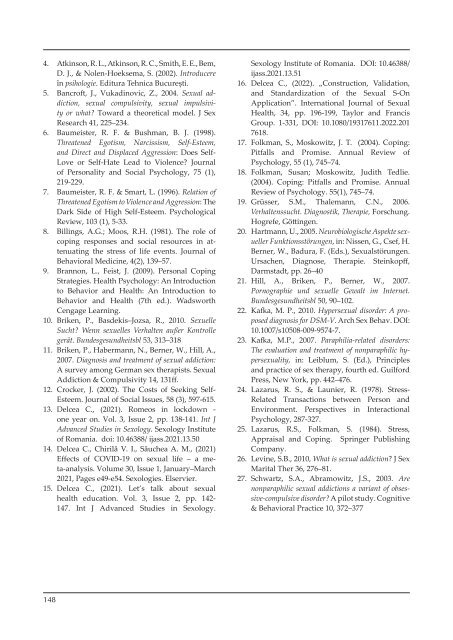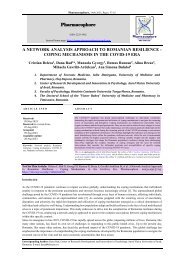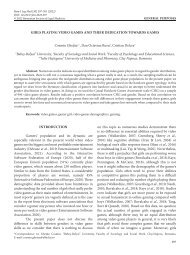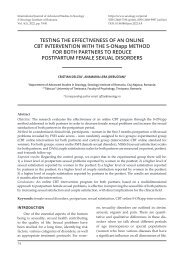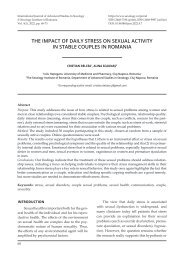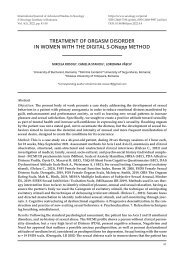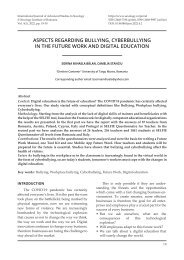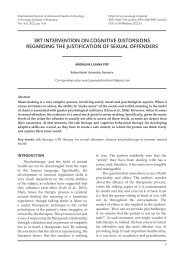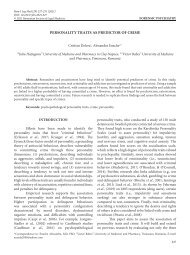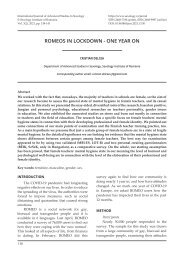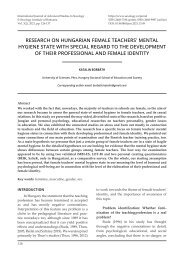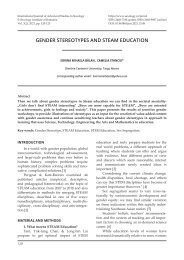Sex as a maladaptive coping mechanism in hypersexuality disorder
The confrontation with the controversial construct of sex addiction reveals not only the heterogeneity of the group of those affected, but also the multitude of aspects that must be taken into account when determining whether this is a singled out, independent disorder or not. Clinical practice experiences also highlight the diversity of relevant influencing factors to consider, as well as the importance of maladaptive coping mechanisms that sustain addiction. The case study presented in this paper was deliberately chosen because clinical cases have repeatedly shown that these two areas, the lack of privacy and the lack of access to their own feelings, play a decisive role in the development of addictions in patients, as well as in the maintenance of this addiction. Therefore, it requires increased attention in therapy.
The confrontation with the controversial construct of sex addiction reveals not only the heterogeneity of the group of those affected, but also the multitude of aspects that must be taken into account when determining whether this is a singled out, independent disorder or not. Clinical practice experiences also highlight the diversity of relevant influencing factors to consider, as well as the importance of maladaptive coping mechanisms that sustain addiction. The case study presented in this paper was deliberately chosen because clinical cases have repeatedly shown that these two areas, the lack of privacy and the lack of access to their own feelings, play a decisive role in the development of addictions in patients, as well as in the maintenance of this addiction. Therefore, it requires increased attention in therapy.
Create successful ePaper yourself
Turn your PDF publications into a flip-book with our unique Google optimized e-Paper software.
4. Atk<strong>in</strong>son, R. L., Atk<strong>in</strong>son, R. C., Smith, E. E., Bem,<br />
D. J., & Nolen-Hoeksema, S. (2002). Introducere<br />
în psihologie. Editura Tehnica București.<br />
5. Bancroft, J., Vukad<strong>in</strong>ovic, Z., 2004. <strong>Sex</strong>ual addiction,<br />
sexual compulsivity, sexual impulsivity<br />
or what? Toward a theoretical model. J <strong>Sex</strong><br />
Research 41, 225–234.<br />
6. Baumeister, R. F. & Bushman, B. J. (1998).<br />
Threatened Egotism, Narcissism, Self-Esteem,<br />
and Direct and Displaced Aggression: Does Self-<br />
Love or Self-Hate Lead to Violence? Journal<br />
of Personality and Social Psychology, 75 (1),<br />
219-229.<br />
7. Baumeister, R. F. & Smart, L. (1996). Relation of<br />
Threatened Egotism to Violence and Aggression: The<br />
Dark Side of High Self-Esteem. Psychological<br />
Review, 103 (1), 5-33.<br />
8. Bill<strong>in</strong>gs, A.G.; Moos, R.H. (1981). The role of<br />
<strong>cop<strong>in</strong>g</strong> responses and social resources <strong>in</strong> attenuat<strong>in</strong>g<br />
the stress of life events. Journal of<br />
Behavioral Medic<strong>in</strong>e, 4(2), 139–57.<br />
9. Brannon, L., Feist, J. (2009). Personal Cop<strong>in</strong>g<br />
Strategies. Health Psychology: An Introduction<br />
to Behavior and Health: An Introduction to<br />
Behavior and Health (7th ed.). Wadsworth<br />
Cengage Learn<strong>in</strong>g.<br />
10. Briken, P., B<strong>as</strong>dekis–Jozsa, R., 2010. <strong>Sex</strong>uelle<br />
Sucht? Wenn sexuelles Verhalten außer Kontrolle<br />
gerät. Bundesgesundheitsbl 53, 313–318<br />
11. Briken, P., Habermann, N., Berner, W., Hill, A.,<br />
2007. Diagnosis and treatment of sexual addiction:<br />
A survey among German sex therapists. <strong>Sex</strong>ual<br />
Addiction & Compulsivity 14, 131ff.<br />
12. Crocker, J. (2002). The Costs of Seek<strong>in</strong>g Self-<br />
Esteem. Journal of Social Issues, 58 (3), 597-615.<br />
13. Delcea C., (2021). Romeos <strong>in</strong> lockdown -<br />
one year on. Vol. 3, Issue 2, pp. 138-141. Int J<br />
Advanced Studies <strong>in</strong> <strong>Sex</strong>ology. <strong>Sex</strong>ology Institute<br />
of Romania. doi: 10.46388/ ij<strong>as</strong>s.2021.13.50<br />
14. Delcea C., Chirilă V. I., Săuchea A. M., (2021)<br />
Effects of COVID-19 on sexual life – a meta-analysis.<br />
Volume 30, Issue 1, January–March<br />
2021, Pages e49-e54. <strong>Sex</strong>ologies. Elservier.<br />
15. Delcea C., (2021). Let’s talk about sexual<br />
health education. Vol. 3, Issue 2, pp. 142-<br />
147. Int J Advanced Studies <strong>in</strong> <strong>Sex</strong>ology.<br />
<strong>Sex</strong>ology Institute of Romania. DOI: 10.46388/<br />
ij<strong>as</strong>s.2021.13.51<br />
16. Delcea C., (2022). „Construction, Validation,<br />
and Standardization of the <strong>Sex</strong>ual S-On<br />
Application”. International Journal of <strong>Sex</strong>ual<br />
Health, 34, pp. 196-199, Taylor and Francis<br />
Group. 1-331, DOI: 10.1080/19317611.2022.201<br />
7618.<br />
17. Folkman, S., Moskowitz, J. T. (2004). Cop<strong>in</strong>g:<br />
Pitfalls and Promise. Annual Review of<br />
Psychology, 55 (1), 745–74.<br />
18. Folkman, Susan; Moskowitz, Judith Tedlie.<br />
(2004). Cop<strong>in</strong>g: Pitfalls and Promise. Annual<br />
Review of Psychology. 55(1), 745–74.<br />
19. Grüsser, S.M., Thalemann, C.N., 2006.<br />
Verhaltenssucht. Diagnostik, Therapie, Forschung.<br />
Hogrefe, Gött<strong>in</strong>gen.<br />
20. Hartmann, U., 2005. Neurobiologische Aspekte sexueller<br />
Funktionsstörungen, <strong>in</strong>: Nissen, G., Csef, H.<br />
Berner, W., Badura, F. (Eds.), <strong>Sex</strong>ualstörungen.<br />
Ursachen, Diagnose, Therapie. Ste<strong>in</strong>kopff,<br />
Darmstadt, pp. 26–40<br />
21. Hill, A., Briken, P., Berner, W., 2007.<br />
Pornographie und sexuelle Gewalt im Internet.<br />
Bundesgesundheitsbl 50, 90–102.<br />
22. Kafka, M. P., 2010. Hypersexual <strong>disorder</strong>: A proposed<br />
diagnosis for DSM-V. Arch <strong>Sex</strong> Behav. DOI:<br />
10.1007/s10508-009-9574-7.<br />
23. Kafka, M.P., 2007. Paraphilia-related <strong>disorder</strong>s:<br />
The evaluation and treatment of nonparaphilic <strong>hypersexuality</strong>,<br />
<strong>in</strong>: Leiblum, S. (Ed.), Pr<strong>in</strong>ciples<br />
and practice of sex therapy, fourth ed. Guilford<br />
Press, New York, pp. 442–476.<br />
24. Lazarus, R. S., & Launier, R. (1978). Stress-<br />
Related Transactions between Person and<br />
Environment. Perspectives <strong>in</strong> Interactional<br />
Psychology, 287-327.<br />
25. Lazarus, R.S., Folkman, S. (1984). Stress,<br />
Appraisal and Cop<strong>in</strong>g. Spr<strong>in</strong>ger Publish<strong>in</strong>g<br />
Company.<br />
26. Lev<strong>in</strong>e, S.B., 2010, What is sexual addiction? J <strong>Sex</strong><br />
Marital Ther 36, 276–81.<br />
27. Schwartz, S.A., Abramowitz, J.S., 2003. Are<br />
nonparaphilic sexual addictions a variant of obsessive-compulsive<br />
<strong>disorder</strong>? A pilot study. Cognitive<br />
& Behavioral Practice 10, 372–377<br />
148


